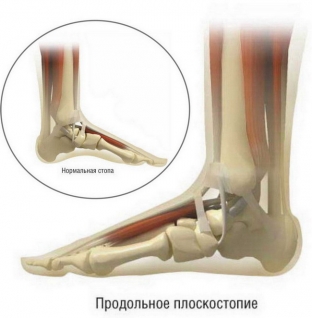With flat feet, the arch of the foot (transverse, longitudinal, or both) is deformed, namely, lowered. This results in minimizing the cushioning properties of the foot. Normal foot function is essential for maintaining balance, correct body position and cushioning shock and repulsion from surfaces while walking. With the weakening of the muscles and ligaments of the feet, the arches of the foot are deformed and become flatter, as a result of which the foot cannot properly perform its functions – they are "delegated" both other joints of the legs and the spine. What is the prevention and treatment of flat feet, as well as the lack thereof, will tell estet-portal.com.
Prevention and treatment of flat feet – what is the danger of foot deformity?
Overloading of the spine and joints, caused by the inability of the feet to perform their functions, often leads to fatigue when walking and pain:
- in the back;
- in feet;
- knees;
- in the thighs.
Intervertebral discs can suffer from such an excessive load, postural disorders are not excluded, and over time the following diseases are not excluded:
- arthrosis;
- scoliosis;
- varicose veins.
Where does flat feet come from?
You should be aware that deformities of the arch of the foot can be caused by various factors. For effective prevention and treatment, the following causes of flat feet should be considered:
- wrong shoes;
- significant weight gain;
- heredity;
- injuries;
- diseases (rickets, poliomyelitis);
- sedentary work;
- significant activity (standing work, running, jumping).
As you probably noticed, the list of causes of flat feet includes both a lack of load and too much load on the foot, which are permanent. It is also worth noting that in rare cases, flat feet can be congenital.
Depending on the cause, acquired flat feet can be:
- traumatic;
- paralytic;
- rachitic;
- static (most common).
Symptoms that indicate the development of flat feet:
- shoe wear from the inside;
- leg fatigue;
- foot pain;
- heaviness in the legs;
- swelling of the ankles;
- low back pain;
- finger deformity;
- leg increase in size.
Fundamentals of prevention and treatment of flat feet in adults and children
 It is important to understand that an adult will not be able to completely recover from flat feet, but it is possible to alleviate the symptoms and improve the condition of the feet to a certain extent. Children's feet that are at the stage of formation, with the right treatment, are quite amenable to correction.
It is important to understand that an adult will not be able to completely recover from flat feet, but it is possible to alleviate the symptoms and improve the condition of the feet to a certain extent. Children's feet that are at the stage of formation, with the right treatment, are quite amenable to correction.
Prevention and treatment of flat feet is aimed at strengthening the weakened muscles and tendons of the foot.
As far as prevention, it consists of wearing comfortable shoes (no heels or platforms), occasional barefoot walking, and regular visits to a podiatrist.
Elementary exercises will also be useful for prevention and treatment:
- Walking with a pencil between your toes (about a minute).
- Walking on toes, on heels, on the outer surfaces of the feet (alternately).
- Squats without taking your feet off the floor.
- When sitting on a chair, moving the feet by flexing and extending the toes (like a caterpillar).
- Picking up small objects with your toes.
- Alternate rotational movements of the shins and feet.
Estet-portal.com reminds that the most detailed and accurate information about the prevention and treatment of flat feet can be obtained from an orthopedist. It is also worth understanding that it is the orthopedist who will be able to make the most effective set of therapeutic measures, based on the degree of development of flat feet, the age of the patient, the type and cause of foot deformities. So, the doctor will prescribe the necessary massages, exercises, wearing orthopedic insoles and, if necessary, painkillers.






Add a comment